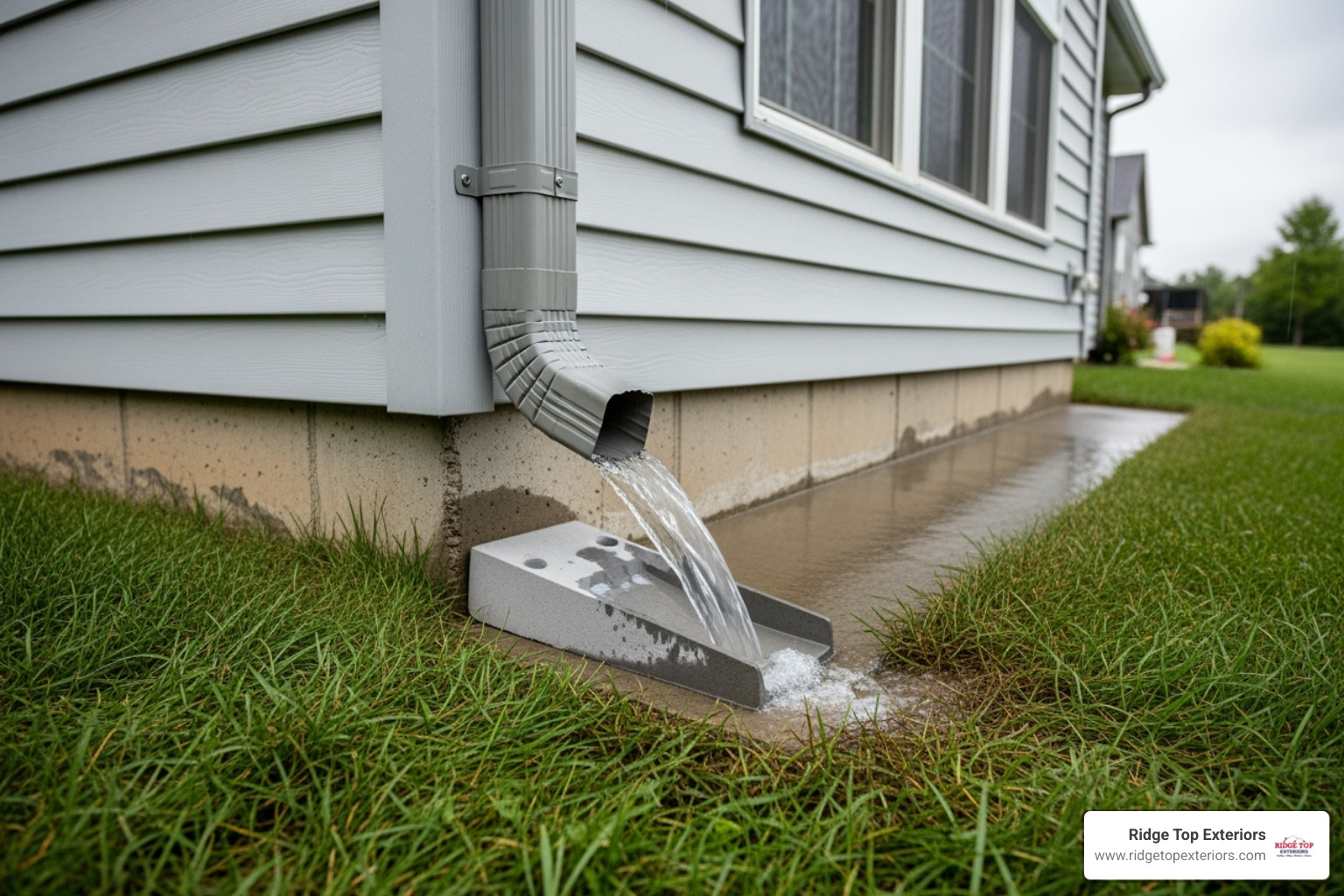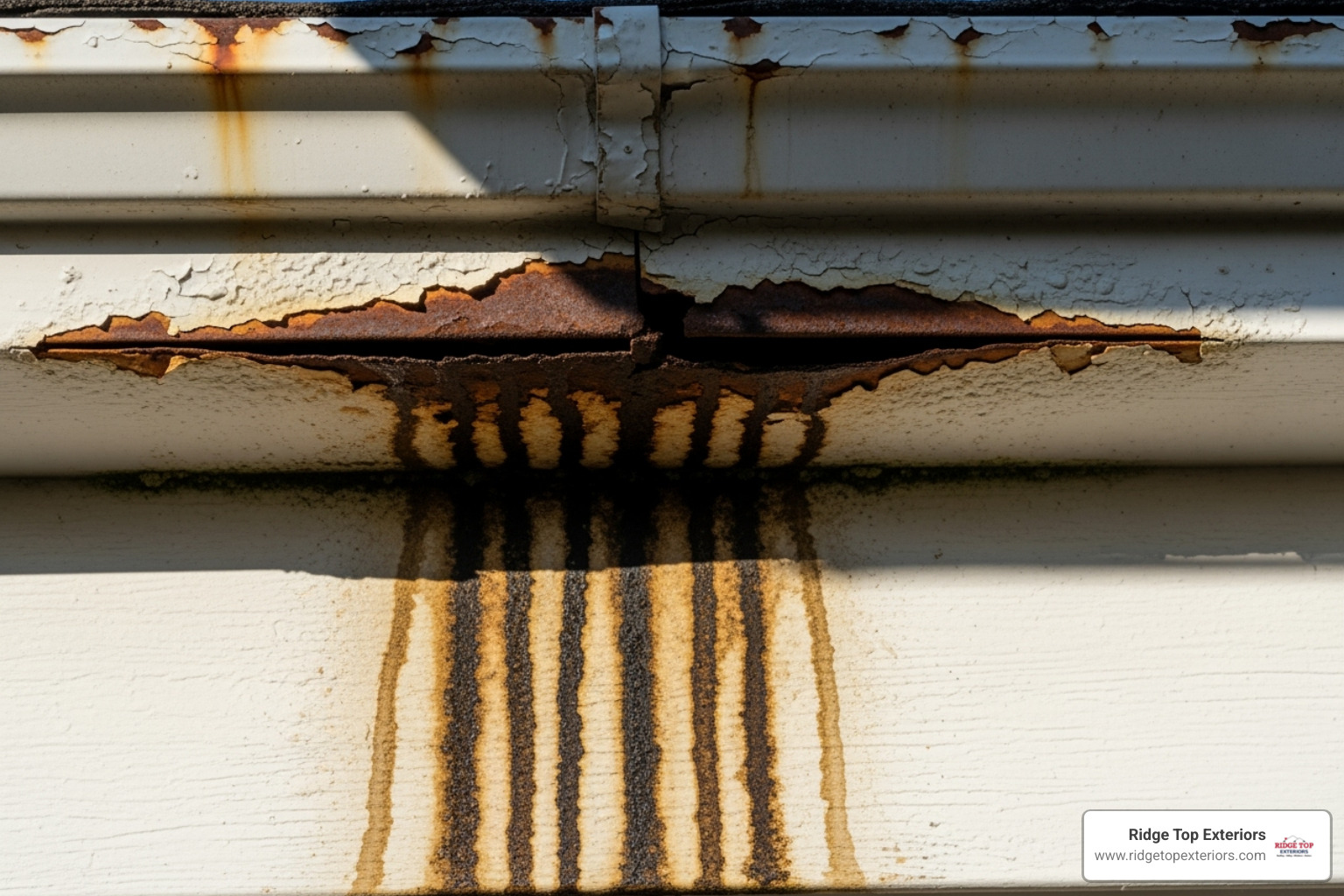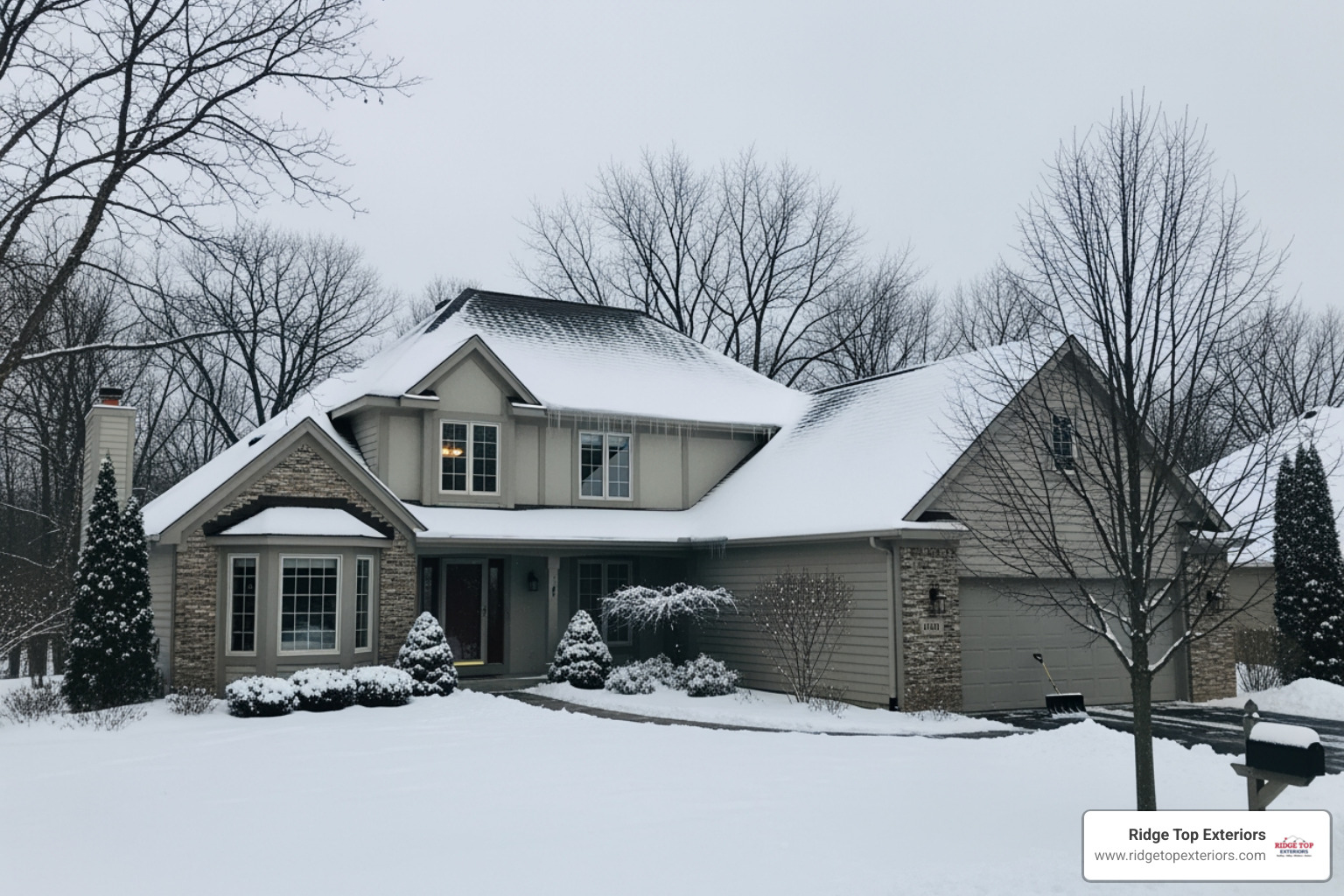
GET UP TO $200 OFF ROOFCARE+ FOR BLACK FRIDAY / CYBER MONDAY! - LEARN MORE!
Protect your home! Find the best gutter company near me for expert installation, repairs, and seamless gutter systems.

When you search for a gutter company near me, you're likely facing one of a few scenarios: water pooling around your foundation, gutters sagging away from your roofline, or you're planning a full exterior upgrade and want gutters that actually work. Here's what you need to know right away:
What to Look for in a Local Gutter Company:
Your gutters do more than channel rainwater—they protect your foundation, prevent basement flooding, preserve your siding and windows, and keep your landscaping intact. When they fail, the damage can cost thousands more than a quality gutter system ever would.
The research backs this up: properly maintained gutters can last 20 to 50 years, but only if they're installed correctly from the start. That means professional pitch and slope, secure fastening to your fascia, and downspouts positioned to direct water well away from your foundation. A 2007 Edmonton-based installer became one of the top eavestrough companies in Alberta by focusing on these fundamentals—and homeowners noticed the difference.
Most gutter installation runs between $4 and $30 per linear foot, depending on material (aluminum, steel, or copper), gutter size (5" or 6"), and whether you add leaf guards or need fascia repairs. Exact pricing requires a free, on-site quote, since every home's roofline, drainage needs, and local conditions are different.
I'm Carter Joyce, Director of Marketing at Ridge Top Exteriors, where I've helped thousands of homeowners across Wisconsin, Illinois, and Florida make informed decisions about their exterior projects—including finding the right gutter company near me to protect their homes for decades. Over the past five years, I've seen how the right gutter system prevents costly water damage and gives homeowners real peace of mind.

Your gutters aren't glamorous—they don't get the same attention as a new front door or a fresh coat of paint—but they're quietly doing one of the most important jobs on your entire property: protecting your home from water damage.
Every time it rains or snow melts, your roof collects hundreds of gallons of water. Without a functioning gutter system, all that water pours straight off the edges, landing right next to your foundation, splashing against your siding, and pooling in places that can cause serious—and expensive—damage.
Foundation protection is where gutters earn their keep. When water isn't channeled away properly, it saturates the soil around your foundation. Over time, this leads to soil erosion that can undermine your home's structural support. In Wisconsin and Illinois, the freeze-thaw cycle makes this even worse—waterlogged soil expands when it freezes, putting pressure on foundation walls and causing cracks. In Florida, intense rainfall can quickly overwhelm the ground's ability to absorb water, leading to similar problems.
The damage doesn't stop at ground level. Water cascading off your roof without gutters splashes back onto your siding and windows, causing stains, mildew, rot, and premature deterioration of materials like vinyl, LP SmartSide, or Hardie siding. Window frames and seals can fail when constantly exposed to water, leading to leaks that damage interior walls and create the perfect environment for mold.
This is where downspouts become critical. They carry collected water from your gutters down to ground level and—when properly extended—direct it at least six feet away from your home. This simple function is your best defense against basement flooding. If you've ever noticed a musty smell or persistent dampness downstairs, failing gutters or improperly positioned downspouts are often the culprit.
Two components that don't get enough credit are your soffit and fascia. The fascia board runs along the roofline where your gutters attach, providing both a finished look and structural support. The soffit covers the underside of your roof's overhang. Together, they protect your roof rafters and attic from moisture and pests. When gutters overflow or pull away, water seeps behind the fascia, causing rot that compromises your entire gutter system—and eventually, your roof's structural integrity.
A well-maintained gutter system isn't just about avoiding leaks—it's about preserving your home's structural integrity from top to bottom. The few hundred dollars you invest in quality gutters and proper installation can save you thousands in foundation repairs, siding replacement, and water damage remediation down the line.
That's why we take Gutters seriously at Ridge Top Exteriors. After 20+ years and more than 45,000 installations across Wisconsin, Illinois, and Florida, we've seen what happens when gutters fail—and how much peace of mind comes from a system that actually works.

Even the best gutter systems eventually show their age. Between harsh weather, falling debris, and simple wear and tear, your gutters work hard—and sometimes they need help. The good news? Your gutters will usually tell you when they're struggling, if you know what to look for.
Catching gutter problems early can save you thousands of dollars in foundation repairs, siding replacement, or basement waterproofing. So when should you start thinking about calling a gutter company near me?
Visible cracks or splits are your first red flag. What starts as a hairline crack can quickly grow into a full split, especially after a hard freeze or two. Water escapes through these openings and drips straight down your home's exterior—exactly what gutters are supposed to prevent. Sectional gutters are particularly vulnerable at the seams, where pieces connect.
If you notice peeling paint or rust on your gutters, that's moisture doing damage. Paint peels when water constantly overflows or leaks, keeping the surface wet. Rust stains on aluminum or steel gutters mean the protective coating has failed and the metal is corroding. Once rust takes hold, leaks aren't far behind.
Sagging or pulling away from the house is hard to miss. Gutters should sit snug against your fascia board, not droop or separate. This happens when gutters get too heavy with water and debris, or when the hangers that hold them up have failed. Sagging gutters can't do their job—water pools instead of flowing to the downspouts.
Look for water stains on your fascia or siding. Those dark streaks or discolored patches below your roofline mean water is going where it shouldn't. It's overflowing, leaking through cracks, or backing up from clogs. Either way, that constant moisture can rot your fascia boards and damage your siding—whether it's vinyl, LP SmartSide, or Hardie.
The presence of mildew or mold growth on your home's exterior is a serious warning sign. That fuzzy green or black growth thrives in damp environments, and it usually appears when gutters are overflowing or leaking regularly. Beyond looking bad, mold can actually damage your home's exterior materials.
Pooling water around your foundation is perhaps the most critical sign of gutter failure. After a rain, walk around your house. See puddles or soggy spots right next to the foundation? Your gutters aren't directing water away like they should. This can lead to foundation cracks, settling, basement flooding, and structural issues that cost far more than new gutters ever would.
Clogged gutters might not be obvious from the ground, but they're one of the most common problems we see. Leaves, twigs, seeds, pine needles, and other debris pile up and block water flow. This is especially true if you have trees nearby—whether it's oak and maple in Wisconsin, or the palms and live oaks in Florida. When gutters clog, water backs up and overflows, defeating the entire purpose of having gutters.
Finally, watch for signs of improper drainage. Even if water makes it into your downspouts, it needs to discharge at least six feet away from your foundation. Short downspouts or broken extensions mean water dumps right next to your house. You'll see eroded mulch beds, washed-out landscaping, or persistently wet spots that never quite dry out.
The most common culprits? Clogs and improper drainage, usually caused by organic debris from surrounding trees. When gutters leak or overflow, we see wood rot on roof edges, saturated foundations, and water seeping into basements.
Don't ignore these warning signs. A small repair today prevents a major problem tomorrow. If you're seeing any of these issues, it's time to have a professional take a look. For more detailed guidance on when replacement makes sense, check out our guide on Top Signs Your Gutters Need Replacing.

When it comes to protecting your home, not all gutters are created equal. Understanding the different types, materials, and available improvements can help you make an informed decision when searching for a gutter company near me.
One of the first decisions you'll face is between seamless and sectional gutters. This choice impacts both the performance and aesthetics of your system.
At Ridge Top Exteriors, we specialize in seamless gutter systems because we believe they offer superior protection and longevity for homeowners in Wisconsin, Illinois, and Florida. The reduction in leak points and the improved aesthetics make them a worthwhile investment. Sometimes, a Subtle Siding and Gutter Upgrade Makes a Huge Difference in your home's overall look and protection.
The material of your gutters plays a significant role in their durability, appearance, and suitability for your local climate. While we primarily work with high-quality seamless aluminum, it's good to understand the options.
| Material | Pros - |
|---|---|
| Aluminum | Pros: Lightweight, rust-proof, and available in a wide range of colors. It's the most popular choice for its balance of cost, durability, and performance. Cons: Can be dented by heavy impacts (like a falling branch or a poorly placed ladder). ' |
| Steel | Pros: Extremely strong and durable, ideal for areas with heavy snowfall or ice. Galvanized steel is rust-resistant. Cons: Heavier and more expensive than aluminum. Can rust if the galvanized coating is scratched. - |
| Copper | Pros: Exceptionally durable (can last over 100 years), develops a beautiful patina over time, and will never rust. It's a premium, high-end option. Cons: Very expensive, both in material and installation cost. - |
| Vinyl | Pros: Inexpensive and won't rust or corrode. Cons: Prone to cracking in cold weather and can become brittle with sun exposure. Often only available in sectional pieces, leading to leaks. - |
No matter what material you choose, the single best upgrade you can make to your gutter system is adding gutter guards (also known as leaf guards or gutter screens). These systems cover your gutters to prevent leaves, pine needles, and other debris from getting in, while still allowing water to flow freely.
At Ridge Top Exteriors, we often recommend and install high-quality systems like Alu-Rex, which are known for their durability and effectiveness. Investing in a quality gutter guard system from the start saves you time, money, and hassle for years to come.
Get your free consultation today!

Considering a 50 year roof Madison? Discover top materials, installation tips, and the 5 best local roofers to safeguard your home.
Read More
Discover what truly earns 5-star roofing reviews. Find a trusted local contractor committed to quality, transparency & peace of mind.
Read More
Protect your business with expert Clearwater commercial roofing. Get a free estimate for durable GAF shingles, repair, or replacement.
Read More